Q1. A group of men decided to a do a work in 7 days. But 10 men dropped out every day, the work completed at the end of the 13th day. How many men were there at the beginning?
(a) 120 men
(b) 130 men
(c) 144 men
(d) 148 men
(e) 169 men

Q2. The efficiency of men, women and children are in ratio 3:2:1. If 20 men,30 women and 40 children together can complete the work in 3 days. Then find out how many men can complete the same work in 10 days?
(a)10 men
(b)12 men
(c)13 men
(d)14 men
(e)16 men

Q3. 12 men and 15 women can finish a piece of work in 10 days and 21 women and 24 children can finish the same work in 15 days. In how many days 1 men ,3 women and 2 children together finish the same work, at their double efficiency?
(a)30 days
(b)33 days
(c)36 days
(d)38 days
(e)34 days
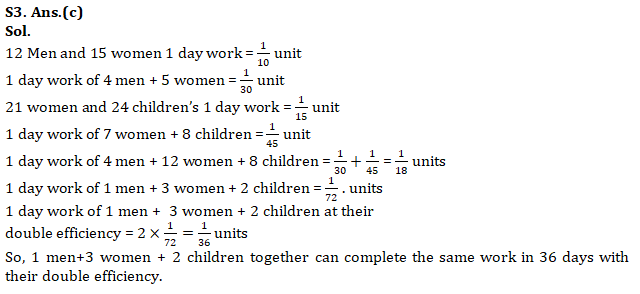
Q4. A can do a piece of work in 42 days. Whereas B is 50/3% more efficient than that of A . find out in how many days B alone can complete same work.
(a)32 days
(b)33 days
(c)34 days
(d)36 days
(e)38 days
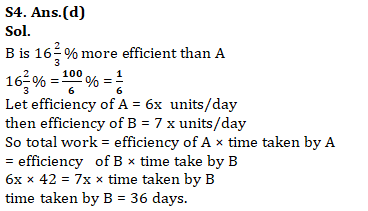
Q5. A, B and C can finish a piece of work in 8 days , 12 days and 16 days respectively. Rs 7800 is the total money allotted to Complete that work. What amount(in Rs) will each person get if all are working together.
(a) 3600,2400,1800
(b) 3300,2400,1800
(c) 3600,2200,1800
(d) 3600,2400,1600
(e) 3000,2400,1600
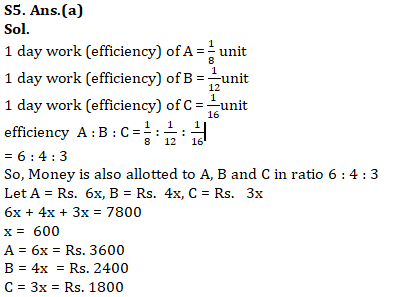
Q6. A takes two times as long as B and C together take to do a job. If all the three working together and complete the job in 24days then find in how many days A will complete the same job ?
(a) 60 days
(b) 70 days
(c) 72 days
(d) 75 days
(e) 78 days
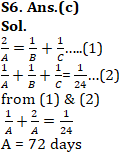
Direction (7-10): In each of these questions, two equations are given. You have to solve these equations and find out the values of x and y and give answer
Q7.
I. x² + 9x – 22 = 0
II. y² – 16y + 64 = 0
(a) if x < y
(b) if x > y
(c) if x ≤ y
(d) if x ≥ y
(e) if x = y or no relation can be established
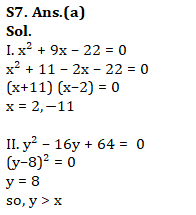
Q8.
I. x² – 5x – 14 = 0
II. y² – 7y + 12 =0
(a) if x < y
(b) if x > y
(c) if x ≤ y
(d) if x ≥ y
(e) if x = y or no relation can be established
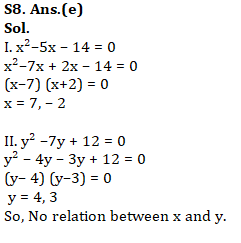
Q9.
I. 3× + 4y = 7
II. 4x + 3y = 7
(a) if x < y
(b) if x > y
(c) if x ≤ y
(d) if x ≥ y
(e) if x = y or no relation can be established

(a) if x < y
(b) if x > y
(c) if x ≤ y
(d) if x ≥ y
(e) if x = y or no relation can be established

Directions (11-15): The following line graph gives the percentage of young people, middle-aged people and old people in the four regions of a state as a percentage of the total young, middle -aged and old people respectively in this state.

Note-1. Ratio of total young people, old people and middle-aged people in this state is 3:5:2.
2. There are only four regions in the state.
Q11. What is the ratio of the total number of young peopl e in north and west region together to middle-aged people in north region?
(a) 20:11
(b) 10:11
(c) 27:16
(d) 5:6
(e) None of the above

Q12. If average no. of old aged people in East and South region together are 6750, find difference between no. of young and middle-aged people in east region?
(a) 2240
(b) 3240
(c) 3380
(d) 3540
(e) 3080

Q13. No. of old aged in south region are what percent more or less than middle-aged in west region?
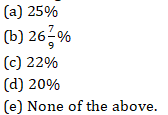

Q14. If population of south region is 9720, find total no. of young people in the state?
(a) 27000
(b) 12400
(c) 5400
(d) 10800
(e) 16200

Q15. Total no. of young, middle-aged and old aged people in east region of state are what percent of total no. of people in the state?


If you want to study Quantitative Aptitude for IBPS PO Prelims then you can also check out the video given below:
- Quantitative Aptitude Study Notes for Bank Exams
- Quantitative Aptitude Questions for all Competitive Exams





 Profit, Loss & Discount – Concept + ...
Profit, Loss & Discount – Concept + ...
 Nainital Bank Recruitment 2025-26 Notifi...
Nainital Bank Recruitment 2025-26 Notifi...
 Daily Current Affairs Quiz 13 December 2...
Daily Current Affairs Quiz 13 December 2...








